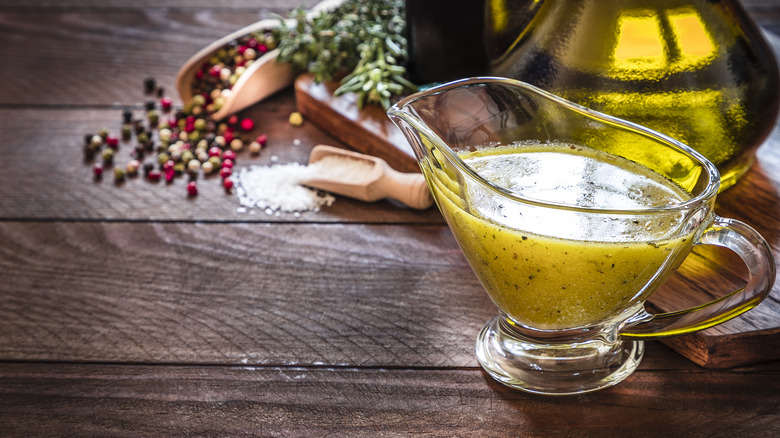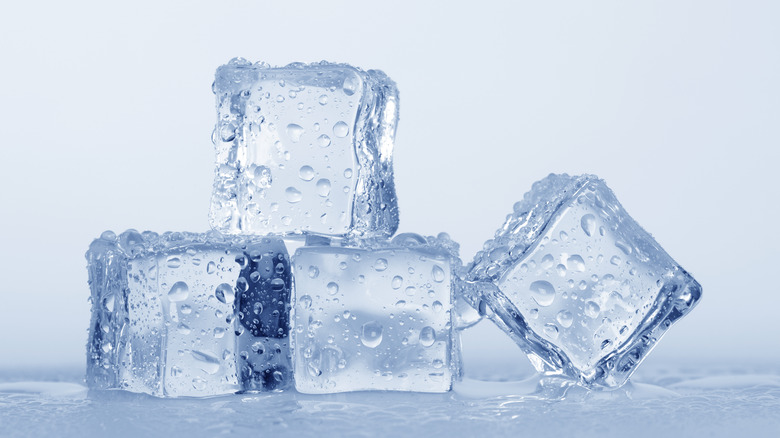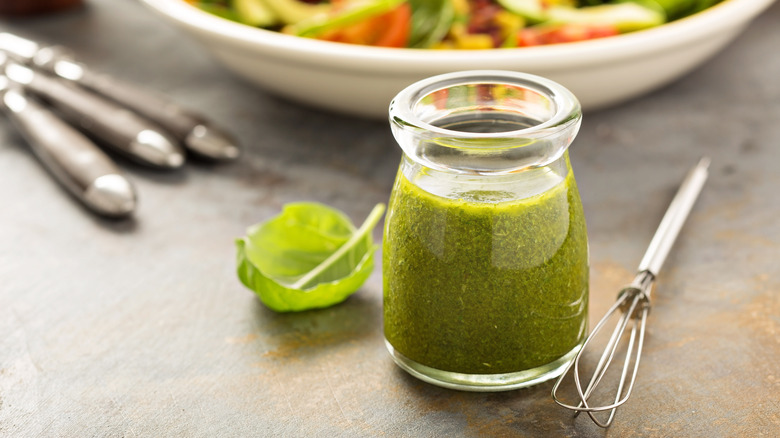You Can't Make The Best Homemade Salad Dressing Without Ice
A salad is only as good as its dressing, and making restaurant-quality dressings at home can be a monumental task. Rather than rush to the store to buy that special seasoning or rare ingredient, adding just a few ice cubes could leave your dinner guests asking for your salad dressing secret.
That secret? Ice. Adding ice to a salad dressing can make it smoother and help it come together more efficiently. Many salad dressings start with a mixture of oil with another liquid, like vinegar, creating an emulsion, meaning the dressing will separate or break if it isn't blended or mixed correctly.
Depending on the type of dressing, adding ice can drastically improve the emulsion of the oil and liquid. In the example of a basic vinaigrette, adding all ingredients to a bottle and shaking is a classic mix method. But, adding an ice cube or two to the bottle will help it mix more evenly and make it less likely to separate, at least if served immediately. Some salads, like TikTok's green goddess salad, call for a thicker dressing that requires a blender or food processor. Fortunately, this trick also works great in the blender, distributing the ice throughout and rapidly decreasing the temperature of the whole dressing.
Why does adding ice to a dressing work?
Emulsion is one of the trickiest kitchen techniques and is incredibly finicky, depending on the recipe. Oil and vinegar do not like each other and will not naturally mix. To create a vinaigrette emulsion, you need to trap tiny bits of vinegar inside the oil so that the two stay together. To do so, the vinegar needs to be broken up to fit within the oil, usually done by rapidly shaking or blending it.
Temperature can aid or hinder emulsion. When a dressing is blended, the particles smashing against each other within the mix help to break down the vinegar. Unfortunately, this also causes friction, creating heat, which increases the chance that an emulsion will break and can cause fresh herbs in the dressing to wilt. Adding ice to your blended dressings helps reduce this heat for better emulsification and brighter herbs.
Remember that water will also be introduced to the recipe as ice melts. So, account for this when measuring your water, vinegar, and other liquids. When shaking a dressing, remove the ice cube before serving, or your emulsion will be watered down, which could cause your dressing to break before you even serve it.
This trick works for more than just a simple vinaigrette, though. Some ice could benefit other dressings that involve creating an emulsion, like Caesar, French, poppy seed, and more.
Other salad dressing tips
Whether making a simple salad dressing or a homestyle ranch from scratch, throwing in an ice cube or two could go a long way to making the dressing smooth and silky. Another way to ensure that your dressing is well blended is to use emulsifying agents. Some can add flavor or texture while others are nearly undetectable.
One of the most popular emulsifiers in dressings is mustard or dijon. Mustard contains mucilage, a compound that reduces surface tension in liquids, helping them to emulsify more easily. It also brings a nice tangy flavor that pairs well with many dressings.
The secret weapon for some chefs' salad dressings is plant gum. You can find various gums, like guar and xanthan gum, in store-bought salad dressings and restaurant recipes. Despite not being common household ingredients, these powerful emulsifiers can be found at grocery stores, which can thicken and emulsify your dressings without changing their flavor.



